This post may contain affiliate links. Please see our disclosure policy.
Chestnut flour is a naturally sweet flour made from chestnuts. It’s been a part of Italian cuisine for centuries, and it’s the perfect gluten-free flour substitute. Learn how to make your own from wild foraged or store-bought chestnuts.
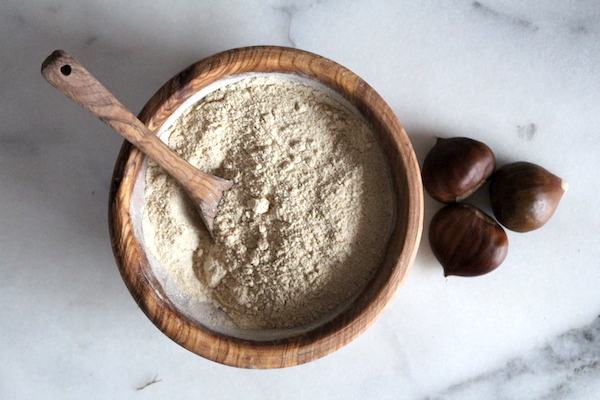
I’m always looking for ways to get more wild foods onto the table, and when I found wild chestnut trees locally I started searching for ways to incorporate their nutritious nuts into our diet.
Chestnut trees used to be a major part of the forests here in the Northeast, as well as in Europe. In Italy, chestnuts were a major source of calories for Tuscan peasants, who turned them into dishes like chestnut soup or ate them roasted out of hand. Fresh chestnuts aren’t nearly as useful or versatile as chestnut flour, and the majority of the crop was transformed into a naturally sweet wild foraged flour.
The resulting chestnut flour would keep for extended periods, and was used in all manner of traditional Italian bread and baked goods. Many traditional Tuscan recipes require chestnut flour, and it lends a distinctive flavor to traditional chestnut pasta, gnocchi, crepes, polenta, and cakes.
Originally considered peasant food, used as a cheaper substitute for wheat flour, these days chestnut flour is part of haute cuisine. Funny how times change. Lobsters used to be reserved only for the poor, and now look how expensive they are.
Chestnut flour is almost impossible to find in stores, even fancy specialty stores. I made a trip into the city and checked several stores, one that had literally 47 types of flour…and everyone looked at me like I had two heads when I asked for chestnut flour.
That leaves you with two options. Buying chestnut flour online, or making your own from fresh whole chestnuts…
How to Make Chestnut Flour
Start with fresh, whole raw chestnuts in the shell. Our local grocery stores carry these around the holidays, from early November through New Years. You can also forage wild chestnuts from local trees, if you’re able to successfully identify them.
Chestnuts have really distinctive spiny casings around the nuts, so if you find one fruiting, it’s easy enough to spot…
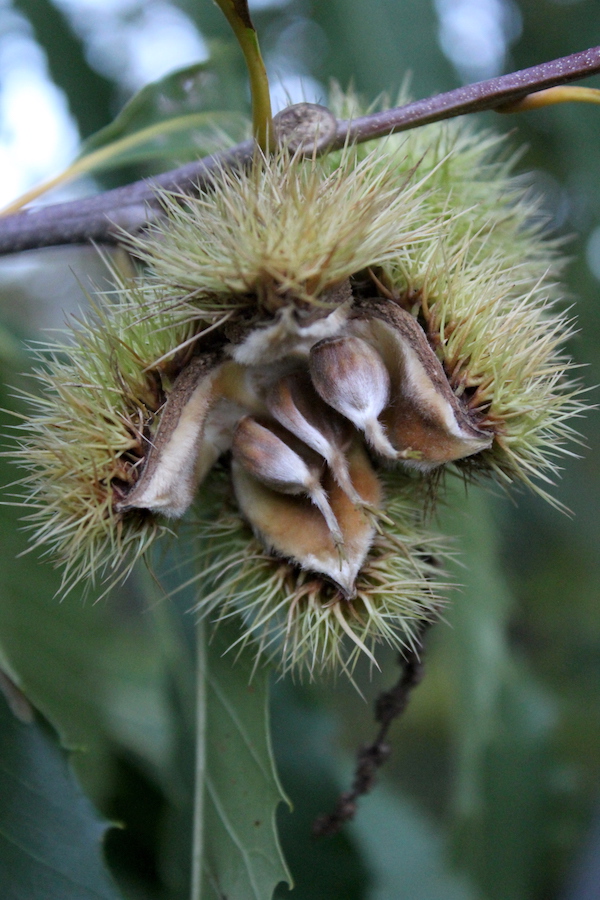
Keep in mind that the chestnuts are going to lose weight and volume during processing, once the shell is removed and the nut is dried into flour. Be sure to start with an ample supply of fresh chestnuts, at least enough for your chosen recipe.
I found that one pound of raw chestnuts in the shell made about half a pound of finished chestnut flour (or roughly 3/4 cup).
Use a sharp knife to slice an “X” into the side of each chestnut. Moisture needs a place to escape while they’re roasting, and the X pattern makes it easier to peel later.
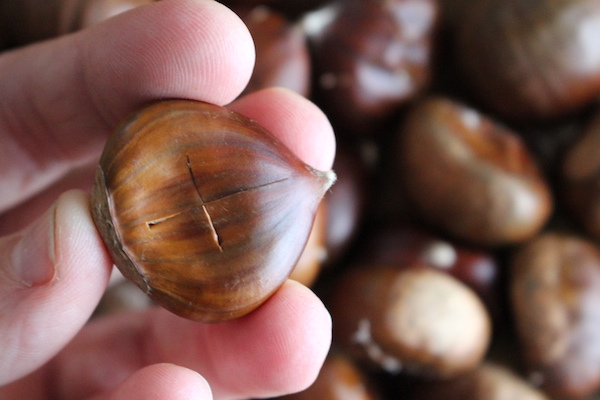
Roast the chestnuts for 25-30 minutes at 400 degrees F.
The roasting helps dry out the chestnut meats, and makes it so you can easily peel off the outer shell. It also greatly enhances their flavor.
Next step…peeling. Chestnuts have two layers that must be peeled off, leaving the sweet inner meat. The outer shell will have peeled back at the corners of the “X” you sliced originally, but the inner shell (or seed coat) will cling tight.
The inner shell is brittle, while nut inside is soft. Press the chestnuts between the palms of your hands and the inner seed coat will shatter off. Working while the nuts are warm helps with this, and if the seedcoats stop shattering off simply re-warm the nuts again.
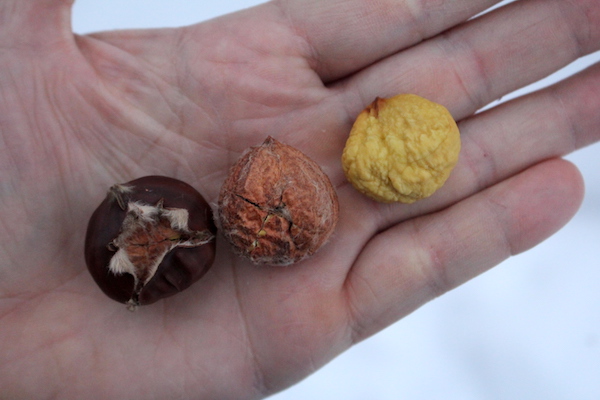
Once the chestnuts are fully peeled, and the bitter inner seed coats have been removed, it’s time to chop the chestnuts. Chopping increases their surface area and makes it easier to dry them for flour.
Mince them finely with a knife, or place them into a food processor.
Spread the chopped chestnut pieces on a food dehydrator tray, and dehydrate at the lowest temperature setting (usually around 105 degrees F) for 12-24 hours (depending on the size of the pieces).

When the chestnut pieces are completely dry, process them in a food processor until you have a fine flour. (Alternately, grind with a mortar and pestle, or get really old school and use a stone flour grinder.)
The finished chestnut flour, if properly dried, will last about 2 months in a sealed container at room temperature. To increase the shelf life to 6-8 months, place the sealed container in the freezer.
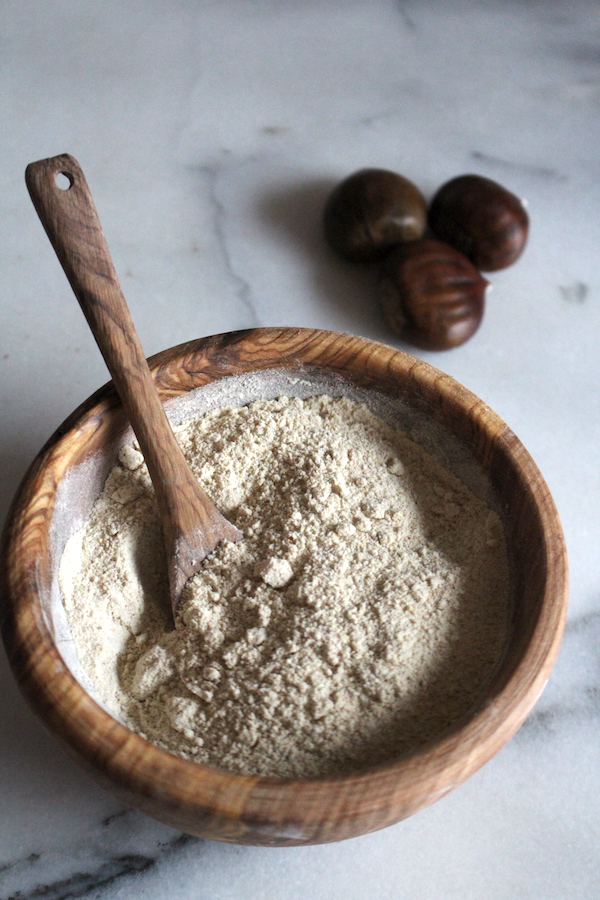
Chestnut Flour Yield
Starting with exactly one pound of chestnuts in the shell (or about 3 cups), I was able to make roughly 1/2 pound of finished chestnut flour (about 3/4 cup). Three cups of chestnuts were roasted, which caused them to lose a significant amount of water weight (while gaining flavor). Once shelled and diced, I was down to about 2 cups of minced chestnut meats.
At that point, they went through the food processor and dehydrator, and then back into the food processor again.
The result was roughly 3/4 cup chestnut flour, and they’d lost about half their original weight in the shelling, roasting and dehydrating.

Traditional Italian Chestnut Flour Recipes
- La Marocca di Casola ~ “an ancient bread typical of one small rural area (Casola, Lunigiana) in Northern Italy. It is made almost entirely with chestnut flour, which is what the locals had in the past, when wheat flour was too expensive. It is dense and has a characteristic flavor. It has recently been recognized as a protected traditional local bread by Slow Food (Presidio Slow Food).”
- Lasagne Bastarde (Bastard Lasagne) ~ “This not very poetic name refers to a type of homemade pasta typical of northern Tuscany, particularly the Lunigiana and Garfagnana area, where sweet chestnuts were once the staple food from late autumn to the end of spring.”
- Necci ~ Simple crepes made from just chestnut flour and water, and filled with either sweet or savory fillings.
- Polenta Di Farina Castagne (Chestnut Flour Polenta) ~ A simple polenta made with just chestnut flour and water.
- Tuscan Chestnut Gnocci ~ A traditional gnocchi made with chestnut flour.
Perhaps the most famous chestnut flour recipe still in use is castagnaccio, or a simple chestnut cake made from chestnut flour, water and olive oil.
According to Great Italian Chefs, “Castagnaccio is probably the most representative recipe that is made with chestnut flour in Tuscany. It is a thin and crisp chestnut cake, an old sweet treat that tells of a time when poverty and hardship were resolved by housewives’ ingenuity. In its simplest version, it is enough to stir a handful of chestnut flour with water, olive oil and rosemary and bake it into a cake with a sharp, almost smoky flavour, with a thick texture similar to a bread pudding.
Talking about castagnaccio in Tuscany, however, might be a thorny issue, because each area uses different dried fruit or focuses on different nuances of flavors. Until recently, I always thought a combination of raisins and pine nuts was best, but now I prefer the castagnaccio of Garfagnana, where you can also find walnuts and the kick of orange zest, which adds a citrus note and turns the castagnaccio into a sweet treat with a typical Christmas flavor.”
While castagnaccio is best known in Tuscany, other regions of Italy have their own distinct variations.
- Castagnaccio Pugliese (Apulian Castagnaccio) ~ Made with eggs, baking powder and a few tablespoons of Cocao powder. This variation is light and airy, like a normal cake. It’s also sweet, from added sugar and dark from the added cocao powder.
- Piedmontese Castagnaccio ~ With added honey, apples and eggs, the Piedmont version is sweeter than the mostly savory Tuscan variation.

Modern Chestnut Flour Recipes
Beyond the traditional Italian ways to use chestnut flour, modern cooks have also come up with a number of creative uses. Chestnut flour is popular with paleo dieters, hoping to find a grain-free flour substitute. Likewise, since it’s naturally gluten-free, you can find it in recipes for celiac sufferers.
Chestnut Flour Bread & Muffin Recipes
- Spiced Paleo Pear Muffins ~ Made with chestnut flour, and topped with a coconut-pecan crumble, these paleo muffins are perfect for fall.
- Chestnut Flour English Muffins ~ Made both paleo and vegan, I’m kind of amazed at how good these look.
- Chestnut Banana Bread ~ A grain-free banana bread made with chestnut flour.
Chestnut Flour Cake Recipes
- Chestnut Cake with Pan-Roasted Pears & Honey Syrup ~ This one pairs a chestnut cake with pears for a fall treat, then tops the whole thing with chestnut honey syrup.
- Paleo Chestnut Flour Cupcakes ~ Made with only chestnut flour, these cupcakes come out fluffy and moist.
- Chocolate Chestnut Fondant Cakes ~ Also called molten lava cakes, there’s a solid cake layer on the outside and a warm chocolate-y filling that pours out once broken with a spoon. This gluten-free recipe uses chestnut flour for a unique flavor in the filling.
- Chocolate Chestnut Cake ~ Made with both chestnut flour and roasted chestnuts, this gluten-free cake is seasoned with chocolate and topped with whipped cream and shaved chocolate.

Chestnut Flour Pies, Bars, Tarts and Cookies
- Cherry Clafoutis with Chestnut Flour ~ Made with a mix of chestnut and almond flours.
- Chestnut Flour Brownies ~ A gluten-free brownie recipe using chestnut flour.
- Chestnut Flour Cookies ~ Combining chestnut flour with wheat flour, this recipe makes a simple roll and cut chestnut sugar cookie.
- Chocolate Chip Chestnut Cookies ~ A gluten-free chocolate chip cookie recipe made using only chestnut flour.
- Chestnut Flour Pizzelle ~ Italian pizzelle cookies made with chestnut flour.
- Pear and Chocolate Chestnut Frangipane Tarts ~ Not gluten-free, but a 50/50 chestnut flour and wheat crust surrounds a chestnut and pear filling in these small handheld tarts.
- Torta Pisticcina (Corsican Chestnut Flour Tart) ~ A simple gluten-free tart made with chestnut flour and almond flour.
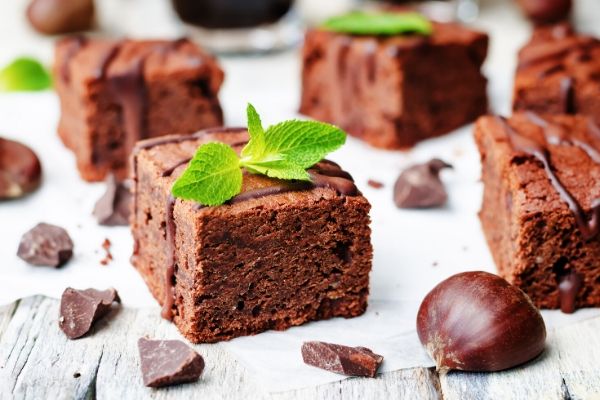
Chestnut Flour Breakfast Recipes
- Paleo Chestnut Flour Coffee Cake ~ Made with a mix of almond and chestnut flour, and sweetened with maple syrup. A crumbly topping made from diced chestnuts, maple and a pinch of cocao powder tops this paleo chestnut flour cake.
- Chestnut Flour Pancakes ~ Made with a mix of chestnut flour and coconut flour, these come out surprisingly fluffy.
- Necci (Chestnut Flour Crepes) ~ Simple crepes made from chestnut flour and water, and served with sweet or savory fillings.
- Chestnut Flour Crepes with Honey, Pine Nuts and Rosemary ~ Unlike necci which are made with just chestnut flour, this recipe also uses white flour. The crepes are more or less flavored with chestnut, and then topped with sweet/savory fillings to give them an Italian flavor profile.
Chestnut Flour Pasta Recipes
- Chestnut Flour Pasta ~ Made from a 50/50 mix of chesnut flour and water, this linguini is recipe uses eggs as a binder similar to most pasta recipes.
- Lasagne Bastarde ~ Made with a 50/50 mix of chestnut flour and water, but unlike the chestnut flour pasta recipe, this traditional pasta uses just water. It’s a poor man’s staple in Tuscany, where chestnut flour was used to extend the wheat flour and eggs were omitted to save money.
- Potato Chestnut Gnocchi with Gorgonzola Cream Sauce ~ The name pretty much says it all for this one…
Chestnut Flour Main Courses
- Chestnut Pizza Crust ~ A grain-free pizza crust made with chestnut flour.
- Rabbit with Chestnut Cake ~ A savory roasted rabbit served with a gluten-free chestnut cake.
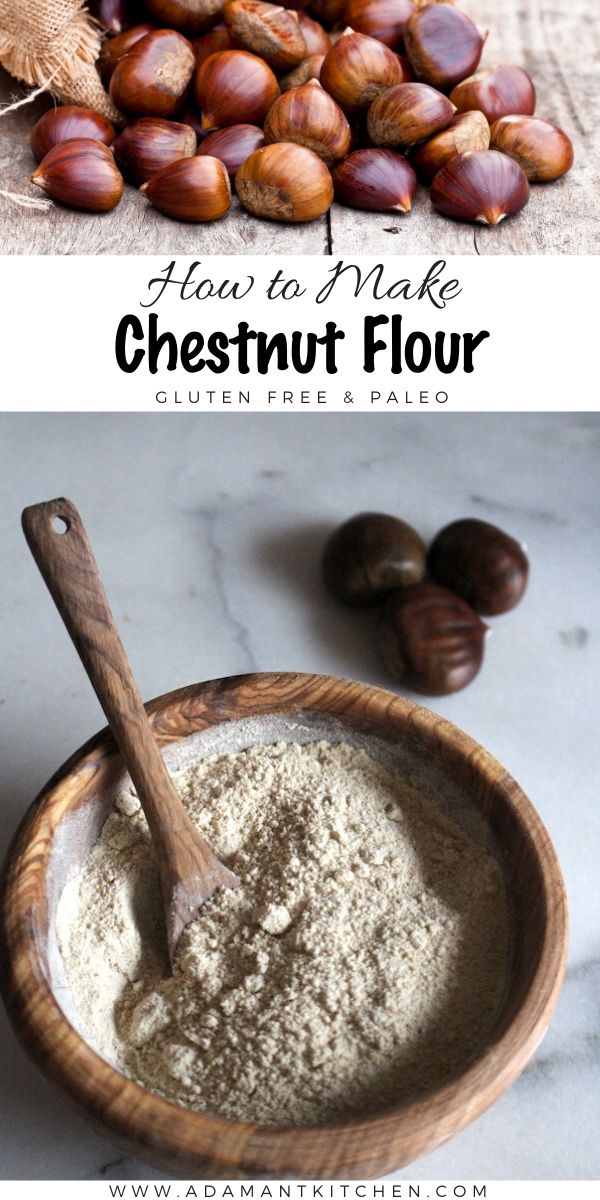
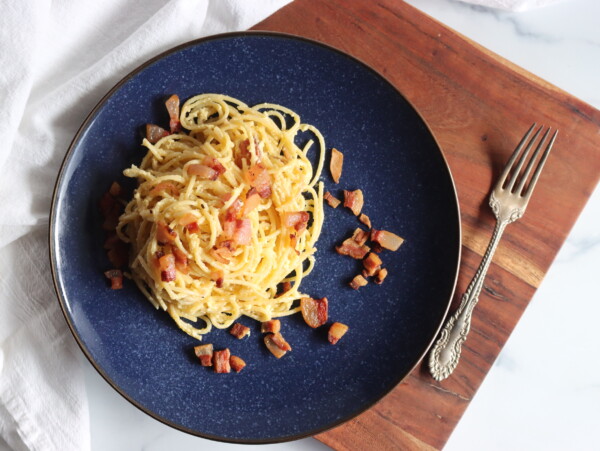


Thank You!
Thanks We tend to make chestnut meal and use it like flour but I’ll try this method next autumn(April May)when we are harvesting.